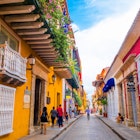

Succulent ossobuco.
Creamy risottos, tender veal shanks and hearty stews lovingly prepared in the home. Milan lies in western Lombardy, a region with rich culinary traditions, where meat features heavily on the menu. You’ll find Milan’s fancy eateries serving creative and sophisticated fare, but you’ll also be able to try rustic wholesome dishes at informal, often family-run trattorie and osterie, where the authentic flavours truly come to life.
Rice plays an integral part in Lombard cuisine, and it thrives in the Ticino and Po river valleys. In winter, polenta (boiled maize meal) is served throughout northern Italy, traditionally accompanied by hearty stews. Lombardy is also one of Italy's largest cheese-making regions – this is the home of tangy Gorgonzola, creamy mascarpone and parmesan-like Grana Padano.

Ossobuco alla Milanese
The name ossobuco (hollow bone) is a reference to the marrow hole in veal shank, which is traditionally braised with vegetables, broth and white wine. The shanks are sprinkled with a thin layer of flour and lightly fried with onions and butter, then left to simmer in broth with tomatoes for about two hours. The result is an exceptionally tender meat dish, often served with polenta or saffron risotto.
Try it
La Dogana del Buongusto offers traditional home cooking in a cosy cavernous interior with bare-brick walls – expect tasty cold-cut platters to start, followed by ossobuco served with risotto alla Milanese.
Antica Trattoria della Pesa
Cassoeula
This hearty winter meat dish typically consists of cabbage and pork, although ingredients can vary slightly from town to town within Lombardy. Richer, heartier versions include pork sausages and vegetables, while more sophisticated recipes use fowl such as goose. The dish is sometimes prepared with pig’s head or trotters and white wine. The cabbage is sweet and tender, traditionally picked after the first winter frost. The meat is simmered in a casserole with onion, celery and carrots for just under three hours, and is frequently served with polenta and accompanied by a full-bodied red wine – the perfect soul-warming dish on a cold and frosty winter’s day.
Try it
Al Bacco
Antica Trattoria della Pesa
Mondeghili
Born as a piatto povero (poor-man’s dish), these succulent meatballs were introduced to Milanese cuisine in the 16th century by the Spaniards who ruled the city for 150 years. Mondeghili were traditionally made with leftover beef; today, sausage, salami and even liver mortadella (a large Italian cooked salami) can be used to enhance flavour. The minced meat is mixed with bread soaked in milk, beaten egg, Grana Padano cheese, garlic or onion and a touch of nutmeg. The mixture is kneaded into oval-shaped meatballs, which are then coated with breadcrumbs and fried in butter, giving them a soft, golden appearance.
Try it
Osteria dell’Acquabella offers hearty traditional Milanese dishes in a laid-back informal setting – the tender mondeghili are served either in a rich tomato sauce or griddled.
La Dogana del Buongusto (see review above)

Risotto alla Milanese
This smooth and creamy saffron-enriched risotto is the culinary pride of Milan. Native to Asia Minor, saffron was introduced to Europe by the Arabs in the 13th century and has featured in Lombard cuisine ever since. Arborio rice is gently pan-fried with chopped onions and butter, and thereafter repeatedly stirred while broth is slowly poured in. Saffron is added later, lending the rice a golden yellow hue, while Grana Padano cheese, stirred in once the rice is cooked, gives the dish a soft and creamy texture. Tender beef marrow (ossobuco) often features in the early cooking stages, giving the dish a wonderful beefy depth.
Try it
Ratanà
Antico Ristorante Boeucc
Cotoletta alla Milanese
There has long been a dispute between Milan and Vienna about the true authorship of cotoletta alla Milanese, or Wiener schnitzel, although most accounts suggest the former can lay claim to its invention. Marshal Radetsky is said to have provided the recipe of this meltingly tender breaded veal cutlet to Emperor Franz Joseph during Austria’s occupation of Lombardy. The chop is cut from the loin of milk-fed veal. It is believed that only the first six ribs can make a perfect cotoletta, as these are neither too thin nor too fatty. Lightly coated in beaten eggs and dipped in breadcrumbs, the cotoletta is then gently pan-fried in clarified butter, resulting in a mouth-watering meat cutlet that is juicy on the inside and crisp on the outside.
Try it
Trattoria del Nuovo Macello
Il Salumaio di Montenapoleone
Insalata di Nervetti
Commonly served as an antipasto (starter) during the warmer months of the year, this veal cut from the lower end of the leg is full of flavour. The kneecap and foot are simmered for over two hours with carrots, celery and onion until the meat falls away from the bone. The meat is then stored in a mould and left to cool as the connective tissues to turn to gelatine. The resultant dish is seasoned with finely cut onions, vinegar, chopped parsley, a drizzle of olive oil and a pinch of salt, and is always served cold, often with beans and pickles.
Try it
Ristorante Solferino
Osteria dell’Acquabella (see review above)

Panettone
Traditionally enjoyed on Christmas day and New Year, this light and airy sweet bread loaf is one of the symbols of Milan. The fluffy dough is mixed with sultanas, candied oranges and lemons, and cocoa butter, and is usually accompanied by a glass of sweet sparkling wine. Panettone was traditionally prepared at home under the watchful eye of the pater familias (head of the household) who, once the cake was baked, carved a cross with a knife as a sign of good luck for the year ahead. Legends of the origins of panettone are wide and varied. One says that, while preparing a Christmas feast, the Duke of Milan's chef, Ludovico Sforza, burned his delectable dessert in the oven. Feeling sorry for the chef, a scullery boy, Toni, rustled up an impromptu cake with the ingredients left in the pantry. The dessert was an instant success among the Duke’s guests, and from that day forth was known as 'pan di Toni', meaning the bread of Toni.
Try it
Last updated in January 2018
Explore related stories

Beaches
Christmas in the Caribbean: 5 places to make the holiday unforgettableNov 11, 2024 • 3 min read


 BeachesCroatia itineraries: 3 routes to explore the cities, coasts and interior
BeachesCroatia itineraries: 3 routes to explore the cities, coasts and interiorNov 8, 2024 • 6 min read



 Destination PracticalitiesGetting connected in Iceland: your guide to eSIMs, wi-fi and mobile networks
Destination PracticalitiesGetting connected in Iceland: your guide to eSIMs, wi-fi and mobile networksNov 14, 2024 • 7 min read


